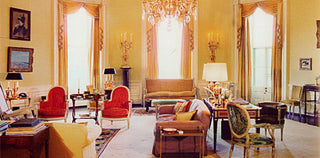Some interior decorators continue to loom large decades after they’ve left us. This spring we thought it would be fun to imagine how they might edit Caspari and which of our patterns they would put together to create a collection in the spirit of their signature style. Follow along over the coming months as we share posts on our design inspiration and some of the most legendary interior designers who continue to have unparalleled influence on generations of designers and tastemakers.
First up, Sister Parish.

Though you may not know of her, Sister Parish created an easy, friendly American country style that since her heyday in the ‘60s, ‘70’s and ‘80s has come to be a mainstream look in American decorating. She had an unerring knack for pulling together a mix of “good” Anglo-American furniture, yards of colorful chintz, exotic wood pieces, elaborately painted floors, and layering in more humble needlepoint pillows, crocheted throws, wicker, quilts, baskets and mattress ticking for slipcovers. Today that mix of high and low feels natural, but when she first came on the scene, Parish was a pioneer.
A 2000 Architectural Digest article described Parish's style: "Her interiors as a rule were refreshingly unstudied, unself-conscious, and unstrained...A Sister Parish room overflowed, to be sure—but buoyantly. It was romantic and whimsical but not sentimental; and, always, it was light—the rug might be Aubusson, the mirror Chippendale and the chandelier Waterford, but she undercut these "brand names" with all manner of charming distractions. Her living rooms lived: They were friendly to the world..."1
Born Dorothy May Kinnicutt in 1910, her brother nicknamed her “Sister” and it stuck. She married Henry Parish II at 19 and they moved into a small white farmhouse in Far Hills, New Jersey, where she immediately set to work making the home the embodiment of her instinctive style. When the Depression hit, she flouted the traditions of her social circle and went to work as “Mrs. Henry Parish II, Interiors.” Friends enamored with the style of her charming home soon became her first clients.
Over the years, Sister Parish would count Astors, Vanderbilts and Rockefellers among her client list. Most notably, Parish decorated a Georgetown house for the young Senator and Mrs. John F. Kennedy, and was later hired by the then First Lady to decorate the private family quarters in the White House. Amusingly, Parish’s name created some confusion, with one newspaper proclaiming “Kennedys Pick Nun to Decorate White House.” Although a rift occurred between Parish and Jackie toward the end of the project and Parisian Stephane Boudin was hired to decorate the State Rooms and add his French touch to the private family rooms, the Yellow Oval Room (the Kennedys’ semi-formal drawing room) remained primarily Parish’s design.

In the early ‘60s, young designer Albert Hadley introduced himself to Parish, and two years later, he was a full partner in the business that evolved into Parish Hadley Associates, one of the most notable interior design firms of the 20th century. “The partnership between Sister Parish and Albert Hadley influenced American design for more than three decades, and the office was a training ground for dozens of designers, who lead the field in their own right today.”2
Parish and Hadley would continue to work together until Parish’s death in 1994. Sister Parish Design was revived in 2000 by Sister’s granddaughter Susan Crater to continue her philosophy of marrying innovation and traditionalism, and ensuring that the legacy of Parish Hadley prints and wallpaper designs remains accessible today.
Our Summer House collection borrows its name from Sister Parish’s family summer home in Isleboro, Maine, which remains a private family home whose design pays tribute to Sister, but continues to evolve from one generation to the next. In describing her mother’s style, daughter Apple Bartlett says “That’s what Mummy was great at. The great mix of whimsy with the good stuff.”3
We imagined Sister Parish might look through our latest collection and come up with the light, airy mix of natural textures, florals, porcelain and chinoiserie that is featured here, all layered up with white washed rattan accessories, soft green trellis patterned lacquerware, and colored acrylic…. And none of it taking itself too seriously! Some of our favorite new patterns include the Mary Delany Flower Mosaics. The pattern looks incredibly fresh and modern, but the flowers are actually paper collages dated 1789, attributed to Elizabeth, Princess of England and Landgravine of Hesse Homburg, in the style of Mrs. Mary Delany, who taught her “flower mosaic” techniques to the Princess. Mrs. Mary Delany was one of the few well-known female artists of her time and her “paper mosaiks” as she called them, were detailed and botanically accurate depictions of plants using tissue paper and hand coloration. These particular examples of her collage style came to us through our partnership with The Newport Garden Club. It just goes to show how a home that is mixes time periods and evolves over time always looks relevant and stylish.
Another favorite design in this collection is Window Garden, painted by artist Katharine Barnwell. Although at first glance Katharine’s cachepots create a charming vignette, the design was actually inspired by hand-sculpted and -painted porcelain flowers, one-of-a kind décor accents beloved by tastemakers for their delicacy and color (not to mention everlasting life). Not all of us can afford these exquisite floral creations, but we can certainly enjoy a cheerful cocktail with Katharine’s napkins.
1Aronson, Steven M. L. "Design Legends: Sister Parish". Architectural Digest. January 1, 2000. Retrieved 2021-02-04
2https://sisterparishdesign.com/blogs/heritage/inside-parish-hadley. June 29, 2020. Retrieved 2021-02-05
3Smith, Clinton. "The Legacy of Sister Parish" . New England Home. November 25, 2019. Retrieved 2021-02-05

